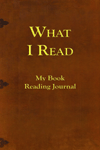 |
|

   
   |
|
|
|
Miscellaneous Books
|
|
|
|
|
|
|
| |
|
|
|
Ghost
Stories |
|
|
|
|
|
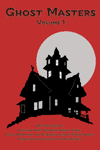
ISBN:
978-1-60459-486-7
|
Readers in
the 19th Century were
firm believers in supernatural phenomena. As a result, numerous writers
exploited this market with ghost stories. Many famous literary authors,
names well-known today, and others, turned their hand to this genre and
created stories that fascinate... and chill. The Ghost Masters
series strives to bring these famous authors, and their stories to the
modern reader. This volume, the first in the series, includes stories
from Henry James (The
Turn of the Screw, The Jolly Corner), Edith Wharton (The Lady Maid's Bell, The Eyes,
Afterward, The Triumph of Night, Kerfol), William Hope
Hodgson (The Gateway of
the Monster, The House Among the Laurels, The Whistling Room, The
Horrse of the Invisible, The Searcher of the End House, The Thing
Invisible), and Elizabeth Stuart Phelps Ward (What Was the Matter, The Tenth
of January, Kentucky's Ghost, Night-Watches, The Day of My Death,
Little Tommy Tucker). If you’re a connoisseur of ghost
stories, then you must add these nineteen stories to your collection. |
 |
 |
 |
|
|
|
|
|
|
| Readers in the 19th Century were
firm
believers in supernatural phenomena. As a result, numerous writers
exploited this market with ghost stories. Many famous literary authors,
names well-known today, and others, turned their hand to this genre and
created stories that fascinate... and chill. The Ghost Masters
series strives to bring these famous authors, and their stories to the
modern reader. This volume includes stories from Washington Irving (The Legend of Sleepy Hollow,
Stories by a
Nervous Gentleman, and The Money Diggers),
Charles Dickens (The
Signal-man, The Haunted House, The Trial for Murder), Elia
Peattie (The Shape of
Fear and Other Ghostly Tales — a collection of thirteen
stories), and Algernon Blackwood (The
Empty House — a collection of ten stories). If
you’re a connoisseur of ghost stories, then you must add these stories
to your collection. |

ISBN:
978-1-60459-485-0
|
 |
 |
 |
|
|
|
|
|
|
|
Richard
Harding Davis |
|
|
|
|
|
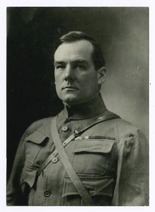
Richard Harding Davis, the son of two writers, was born
in Philadelphia in 1864. After an education at the Episcopal Academy
and Johns Hopkins University, he became a journalist. His first job was
as a reporter for the Philadelphia Press in 1885. In 1888 he moved to
the New York Sun on the reporter’s beat, while also writing fiction
around his character Cortlandt Van Bibber. His novella “Gallegher”
(1890), about a copy-boy who rose from obscurity when he captures a
murderer was followed by “Gallegher
and Other Stories” (1891). Soon
after its release he was appointed editor of Harper’s Weekly but was
already setting his sights on becoming a foreign correspondent.
As well as articles, he wrote books about his travels,
including “The King’s
Jackal” (1891), (made into a movie in 1924 called “Honor Among Men”),
“The West From A
Car Window” (1892), “Three
Gringos
in Venezuela and Central America” (1896), “Cuba in War Time”
(1897) and “Soldiers of
Fortune” (1897).
The Spanish-American war of 1898 found Davis as the
Cuban war
correspondent for the New York Herald, bringing Theodore Roosevelt and
his “Rough Riders” regiment to the front page. Roosevelt, who became
fast friends with Davis, called him one of the most courageous men
there. There was speculation at the time that Davis was involved with
William Randolph Hearst’s plotting to start the war in order to boost
his newspapers sales, but when articles he wrote from his Cuban
experience were altered to create sensation, Davis resigned.
On the home front, Davis and Cecil Clarke were married
on 4 May, 1899
(The same year he wrote “The
Lion and the Unicorn”). After extensive
world travels they settled in Mount Kisco, New York in 1905.
Davis also covered the war between Britain and the Boer
South Africans. “The
Bar Sinister”
(1903) was made into a film titled “It’s
a Dog’s
Life in 1955.” “Notes of a War Correspondent” (1910)
followed, and he
also wrote a number of plays including “The Dictator”
which was
released in 1904, the same year his father died, and “Miss
Civilization” (1906), and “Peace Manoeuvres”;
a play in one act (1914).
By the outbreak of the First World War, Davis was the
most experienced
and respected war correspondent in America. Captured by the German Army
in 1914, he was threatened with execution as a British spy. Harding
remained in Europe until 1915, but was unhappy with the restrictions
imposed on him by the Allied authorities. Before returning to America
he was quoted as saying he was not staying “to write sidelights.”
It is said that Davis always retained an air of youth,
his writing
fiercely acerbic, buoyed by conviction. His charm and exuberance
attracted many admirers, and his bravery during war reportage earned
the utmost respect of his peers, though he was sometimes accused of
romanticising and sensationalism. There was a time when three of his
plays were running simultaneously on Broadway and many of his novels
were best-sellers. Richard Harding Davis died in 1916.
#Major Genres: Drama, Romance, Detective.
Here
is a handy index to the Richard Harding Davis fiction short stories and
novels published by Flying Chipmunk Publishing, so you can easily find
the book you want. There is also an index to short stories and novels
as they were published by Charles Scribner's
Sons, Richard Davis' publisher, between 1890 and 1916.
Complicating the
release
information provided is that it was not unusual for Charles Scribner's
Sons to
reissue books with the same titles but with different story contents.
Thus, the book “The
Exiles and Other Stories,” published in 1894, was
re-released with the same
title in 1916, but with five of the original seven stories
replaced by
others. And the book “The
Princess Aline” (released in 1895) and “The Scarlet Car"
(released in 1906) were re-released as a single book “The Scarlet Car, The Princess
Aline” in 1912, and then “The Princess Aline”
was released again in the 1916 edition of “Gallegher and Other Stories”
which itself was a reprint of an earlier edition.
Gallegher,
Van Bibber,
and
Other Stories
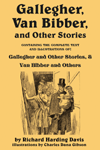 |
Captain Macklin, Ranson's Folly,
The Bar Sinister, and In the Fog
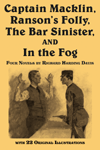 |
The King's Jackal,
Once Upon a Time, Cinderella, and Other Stories
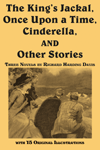
|
The
Scarlet
Car, The White Mice,
and
Other
Stories
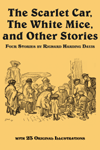 |
The
Red Cross
Girl,
and
Vera the Medium
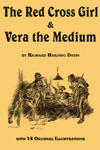 |
The
Princess Aline &
The
Man Who Could Not Lose
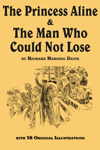 |
The Lost
Road &
The Lion and
the Unicorn
 |
Stories
for Boys &
The
Exiles and Other Stories
 |
|
|
|
|
|
|
 |
|
|
|
|
|
 ISBN: ISBN:
978-1-61720-125-7
|
“Gallegher and Other Stories” —
The leading reporter (Richard Harding Davis) for the New York Sun in
the 1890’s published this collection of stories about an intrepid
newspaper copyboy with a talent for crime detection, which helped make
Davis one of the most popular authors in America during the decade.
This book also introduces Courtlandt Van Bibber the wealthy
man-about-town.
“Van Bibber and Others” — This book collects
stories concerning Davis’s most popular creation, the wealthy
man-about-town Courtlandt Van Bibber, who provides a lens on the often
ridiculous antics of the rich and famous in Newport and along New
York’s Park Avenue at the turn of the 20th Century.
What the
critics said: As pictures of human life in a great city, these ...
stories are simply unique. —Newark Advertiser.
Mr. Davis is a
writer of unquestioned genius. His sketches of city life in the poorer
districts have a force which makes them exceptionally vivid and
inspiring. —Albany Express.
... remarkable newspaper and
magazine stories. They will make capital winter reading, and the book
is one that will find a welcome everywhere. —N. Y. Journal of
Commerce.
The freshness, the strength, and the vivid
picturesqueness of the stories are indisputable, and their originality
and their marked distinction are no less decided. —Boston Saturday
Gazette.
His figures stand forth clear cut, and
marvelously truthful and lifelike. Their wholesome tone is in grateful
contrast to the false and exaggerated note so often struck by young
authors. — Philadelphia Ledger.
“Gallegher
And Other Stories” has the stories: Gallegher: A Newspaper Story; A
Walk Up the Avenue; My
Disreputable Friend, Mr. Raegen; The Other Woman; The Trailer for Room
No. 8; “There Were Ninety and Nine”; The Cynical Miss Catherwaight; Van
Bibber and the Swan-Boats; Van Bibber’s Burglar; and Van Bibber as Best
Man.
“Van
Bibber and Others” has the stories: Her First
Appearance; Van Bibber’s Man-Servant; The Hungry Man was Fed; Van
Bibber at the Races; An Experiment in Economy; Mr. Travers’s First
Hunt; Love Me, Love My Dog; Eleanore Cuyler; A Recruit at Christmas; A
Patron of Art; Andy M’gee’s Chorus Girl; A Leander of the East River;
How Hefty Burke Got Even; Outside the Prison; and An Unfinished Story.
“Gallegher
And Other Stories” and “Van Bibber and Others,”
were
published in 1891 and 1892, respectively, and this volume includes the
original illustrations from those editions.
|
 |
 |
 |
|
|
|
|
|
|
|
“Captain
Macklin” — Royal Macklin is tossed out
of West Point because of a minor infraction. This displeases the father
of his sweetheart Beatrice and he forces the young couple to break up.
But as he says good-bye, Macklin swears that he will make good. He
decides to travel to Honduras to join up with soldier of fortune
General Laguerre, fighting for the freedom of the Honduran citizens.
“Ranson’s Folly” — Lt. Ranson, an army officer,
out of boredom,
bets his friends that he can successfully pull off a stagecoach robbery
armed with nothing more than a pair of scissors. Disguised as the
notorious masked bandit “the Red Rider,” Ranson makes good his wager.
Unfortunately, the army paymaster is shot shortly thereafter. All
evidence points to the Red Rider — and, of course, to the innocent Lt.
Ranson. It appears as though the genuine culprit is the father of
Ranson’s sweetheart...
“The
Bar Sinister” — Told from a dog’s
point of view, this Horatio Alger-style rags-to-riches story is about
“The Kid,” a street bull-terrier and his rise to “Best in Show” (based
on the life of a real dog).
“In
the Fog” — One of Davis’ most
famous works: While dining at a club, four gentlemen begin spinning
murder stories in an attempt to detain Sir Andrew from speaking at the
House of Commons (Sir Andrew frequently forgets what he’s doing and
where he’s going when reading crime novels). One starts off by relating
how one night he got lost in a thick London fog. He stumbled
upon a house where a a young nobleman and a Russian princess had just
been murdered. He escaped from the house and reported the
killings to Scotland Yard. But they were unable to find the
location of the dwelling. The next speaker relates that the
murdered Princess, was known to him personally. And the next claims to
know the family of the murderer. Will the four men succeed in making
Sir Andrew miss his engagement at the House of Commons?
This
volume includes the complete text of all four novels, published in
1902, 1902, 1903, and 1901, respectively. Also included are the
original full-page illustrations that graced those volumes.
|

ISBN:
978-1-61720-126-4


 |
|
|
|
|
|
|
 ISBN: ISBN:
978-1-61720-127-1
|
“The
King’s Jackal” —
Richard Harding Davis’s daring adventure set in a dangerous, foreign
land. The exiled King of Messina, and Baron Kalonay, plot to
re-establish the king’s financial fortunes by purchasing arms and
invading his former country! The only one standing in the way of the
diabolical plans of the bankrupt exiled King is a courageous American
reporter. But is the King really planning an invasion? If he isn’t,
what is his plan?
“Once
Upon a Time” — A collection
of eight of Davis’s short stories, drawn from his experiences abroad as
a correspondent. “A
Question of Latitude” deals with European cruelty
and misrule in the Congo. “The
Spy” visits the South America of
dictators, revolutions, and corrupt financial schemers from the U.S.
Also included are “The
Messengers,” “A Wasted Day,” “A Charmed Life,”
“The Amateur,” “The Make-Believe Man,” and “Peace Maneuvers.”
“Cinderella
and Other Stories” — Five stories, starting with the one
naming the book: “Cinderella,”
an outing with Van Bibber in which he
and a friend think the have found a Cinderella, but discover it is not
as easy as the fairy tale makes it sound. “The Reporter Who Made
Himself King” follows a reporter who wants to cover a war
but is posted
to a remote island; the appearance of a German ship provides him an
excuse to write a thrilling report, but then things go wrong, very
wrong. “Miss Delamar’s
Understudy,” “The Editor’s Story,” and “An
Assisted Emigrant” round out the collection.
This volume
includes the complete text of all three novels, published in 1902,
1902, and 1901, respectively (“The
Reporter Who Made Himself King”
appeared in both “The
King’s Jackal” and “Cinderella
and Other
Stories,” but is included here only in “Cinderella and Other
Stories.”) Also included are the original 15
full-page
illustrations that graced those volumes.
|
|
 |
 |
 |
|
|
|
|
|
|
|
“The
Scarlet Car” — Written in 1906, when
automobiles were still something of a novelty, this is a set of three
stories based on the adventures of Winthrop, Sam, Beatrice, and
Peabody. First , they get accused of speeding in a small town, then the
car breaks down on a remote country lane, and finally, they
accidentally run down a man in the street while helping Peabody, an
aspiring politician, run up the vote on election day. Can they keep
this from costing Peabody the election?
“The
White Mice” — Four
Americans make a solemn pact to combat tyranny and save human lives.
Thus begins the Secret Order of the White Mice. Roddy
Forrester’s father owns the Forrester Construction Company, a big
concern which builds lighthouses. To give his son a taste of business,
he sends him to Venezuela as a foreman. But he doesn’t want Roddy to
know too much about company policy—least of all its political
intrigues. Once there Roddy finds Don Miguel Rojas, a patriot unfairly
put in prison. It’s unlikely that anyone will bust him out, until White
Mouse Roddy hears about his plight and decides to do something.
“A
Derelict” — Judged to be Davis’ best short story, “A
Derelict” is
based on the battle of Santiago Bay (July 3, 1898) in which the
American fleet destroyed the Spanish fleet. The story is in part an
attack on Consolidated (Associated) Press, and a contrast between two
newspapermen — a drunken CP man whose talent has been repressed by the
CP’s demand for cold, colorless “facts” and a ne’er-do-well free-lancer
who is nevertheless a genius writer.
“La
Lettre d’Amour” — The
lover who will take no, and goes on his way disconsolate, may live to
love another day, and everyone is content; but the one who will not
have no, who will not hear of it, nor consider it, has much to answer
for in making life a burden to himself and all around him. This is the
story of one such lover, and how Edouard, the second violinist, showed
him the hopelessness of his position.
This volume includes the
complete text of all the stories, published in 1907, 1909, 1902, and
1902, respectively. Also included are the original 23 full-page
illustrations that graced these stories.
|

ISBN:
978-1-61720-128-8
|
 |
 |
 |
|
|
|
|
|
|
 ISBN: ISBN:
978-1-61720-129-5
|
“The
Red Cross Girl” — Written
in 1912, updated with two additional stories in 1919, and ranging from
New York to Cuba to Britain, this is a collection of nine of Davis’s
dramatic and gripping stories. An American sets out to fake a German
invasion of England, a salesman missing his train ends up accidentally
participating in an invasion of Cuba, a student who flunked a history
course helps his professor regain his position after being unfairly
booted from the college (by turning him into a world-wide
celebrity!), a man about to give up discovers he can actually
read people’s minds, and five other tales will hold you riveted in this
book. The stories included are: “The
Red Cross Girl,” “The Grand Cross
Of The Crescent,” “The Invasion of England,” “Blood Will Tell,” “The
Sailorman,” “The Mind Reader,” “The Naked Man,” “The Boy Who Cried
Wolf,” and
“The Card-Sharp.”
“Vera
the Medium” — The romance of
Vera the Medium, a young woman who “speaks” to the spirits of the dead.
Trapped in a profession of lies by something she did years before, Vera
meets the District Attorney, Winthrop, who offers her hope of a way
out. But will her compatriots and clients let her go? Full of tragedy
and humor, a thrilling love story as only Richard Harding Davis can
tell. The heroine is a kind new to fiction and the story is told with
the vigor and skill.
This volume includes the complete text of
all the stories, published in 1912, and 1919 editions. Also included
are the original 14 full-page illustrations that graced these stories.
|
 |
 |
 |
|
|
|
|
|
|
|
“The
Princess Aline” — Morton Carlton, a
portrait-painter of international reputation, is unlucky in
love. It’s not that he never meets the right women. It’s only
that when the right “one” comes along, he changes his mind.
Indeed, it seems he is destined to forever wander like a lost votary
through Venus’s domains. But one day a change appears on the
horizon. He sees a portrait of the Princess Aline of
Hohenwald in an illustrated newspaper, and falls madly in love with his
artist’s conception of her. Throwing all to the winds, he
resolves to go to Europe and look her up. The quest begins.
As is usual with Davis’s stories, the plot moves right along.
There are interesting diversions in each of the major capitals at which
the travelers stop, and these give unmistakable local color and
interest to the whole. However, the preservation of Imperial
Europe’s unique flavor is what gives this novel its chief value.
Published in 1895.
“The
Man Who Could Not Lose” — Published in
1911 and updated with an additional story in 1917, these eight stories
continue Davis’s fine tradition of dramatic and gripping writing.
Beginning with a nearly destitute couple who risk their last savings on
a race-track dream, then to a Foreign Service Civil Agent who risks his
career refusing the demands of a powerful Senator, to a reporter who
believes a story is hidden in a piece of paper found in a street
gutter, these stories will keep you spell-bound in your seat. The
stories included are: “The
Man Who Could Not Lose,” “My Buried
Treasure,” “The Consul,” “The Nature Faker,” “Billy and the Big Stick,”
“The Frame-Up,” “The Lost House,” and “The Log of the ‘Jolly Polly’.”
Includes a commemorative foreword written by Leonard Wood.
This
volume includes the complete text of all the stories, published in
1895, 1911, 1915, and 1917. Also included are the original 18 full-page
illustrations that graced these stories.
|

ISBN:
978-1-61720-423-4
|
 |
 |
 |
|
|
|
|
|
|
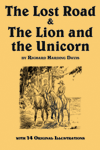 ISBN: ISBN:
978-1-61720-424-1
|
“The
Lost Road” — Published in
1913 and updated with three additional stories in 1917, this is a
collection of ten of Davis’s dramatic and gripping stories. From
soldiers who never give up, to how a Boy Scout saved hundreds of jobs
and large company from disaster, you will find these stories well worth
your time. The stories included are: “The Lost Road,” “The Miracle of
Las Palmas,” “Evil to Him Who Evil Thinks,” “The Men of Zanzibar,” “The
Long Arm,” “The God of Coincidence,” “The Buried Treasure of Cobre,”
“The Boy Scout,” “Somewhere in France”, and “The Man Who Had
Everything” (also known as “The Deserter”).
Includes a commemorative
foreword written by John T. McCutcheon.
“The
Lion and the
Unicorn” — Published in 1899, these five stories continue
Davis’s fine
tradition of dramatic and gripping writing. A playwright goes to London
to make his name, but finds love instead; A wounded soldier on a
hospital ship struggles through hallucinations and delirium and refuses
to die because his girl is on her way to care for him, she has promised
so; a politician is placed in an awkward situation; a vagrant turns out
to be more than he first appears; and three viewpoints on a rebellion
in South Africa. The stories are: “The
Lion and the Unicorn,” “On the
Fever Ship,” “The Man with One Talent,” “The Vagrant,” and “The Last
Ride Together — A Sketch Containing Three Points Of View.”
This
volume includes the complete text of all the stories, published in
1899, 1913, 1915, and 1917. Also included are the original 14
illustrations that graced these stories.
|
 |
 |
 |
|
|
|
|
|
|
|
“Stories
for Boys”
— Published in 1891, this is a collection of
six
of Davis’s dramatic and gripping stories for boys. These are from early
in his career and focus on boys and young adults, including two stories
featuring one of Davis’ most popular characters: Van Bibber. The
stories range from a boat race between rival hotels; a baseball star
who injures a bystander at a game; a tennis star who runs up against
some dishonest players and judges; kids playing a dangerous game of “I
dare you;” a Circus outing with Van Bibber, and a novice jockey hit
with temptation to throw a race. The stories included are: “Midsummer Pirates,” “Richard
Carr’s Baby,” “The Great Tri-club Tennis Tournament,” “The Jump at
Corey’s Slip,” “The Van Bibber Baseball Club,” and “The Story of a Jockey.”
“The Exiles and
Other Stories” — Published in 1894, this is a collection
of seven stories, one of which is a record of one of Davis’ real
experiences in England breaking the law, and continue Davis’s fine
tradition of tight writing, including another Van Bibber story where he
is the victim of a slanderous letter. The stories are: “The Exiles,” “The Writing on
the Wall,” “The Right of Way,” “His Bad Angel,” “The Boy Orator of
Zepata City,” “The Romance in the Life of Hefty Burke,” and “An Anonymous Letter.”
This volume includes the complete text of all the
stories,
published in 1891 and 1894. Also included are the original 17
illustrations that graced these stories.
|

ISBN:
978-1-61720-431-9
|
 |
 |
 |
|
|
|
|
|
|
|
|
|
|
|
|
|
|
|
Charles Dickens |
|
|
|
|
|
Charles
Dickens was an English novelist and is generally considered
the greatest of the Victorian
period. Dickens enjoyed a wider popularity and fame than
had any previous author during his lifetime, and he remains popular
today, having been responsible for some of English literature's most
iconic novels and characters. Here ae a few of his most famous works,
all of which have been made into movies, some more than once.
|
|
|
|
|
|
 |
|
|
|
|
|
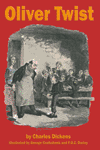 ISBN: ISBN:
978-1-60459-484-3
|
One
of Dickens’ most enduringly popular stories is “Oliver Twist”, his
second novel, published in installments starting in February 1837 and
continuing until 1838. Like many of his later novels, its central theme
is the hardship faced by the dispossessed and those outside “polite”
society.
The initial chapter describes the birth of the
main character Oliver Twist. His mother has been found lying in the
street, her shoes in shreds from walking. She is brought to a workhouse
in England, and the next night gives birth to Oliver, delivered by a
surgeon and a drunken nurse. Oliver struggles to breathe at first, but
once established, cries heartily. His mother asks to see him, and dies
once she has placed a kiss on him. She is unmarried, and no one knows
her identity. Oliver is left at the workhouse in the care of the nurse.
Oliver
is treated cruelly there as was the norm at the time for pauper
children, in particular by Bumble, a parish council official or
“beadle”. The story follows Oliver as he escapes the workhouse and runs
away to London. Here he receives an education in villainy from the
criminal gang of Fagin that includes the brutal thief Bill Sikes, the
famous “Artful Dodger” and Nancy, Bill’s whore. Oliver is rescued by
the intervention of a benefactor — Mr Brownlow — but the mysterious
Monks gets the gang to kidnap the boy. Why is Monks interested in
Oliver, and how does that pertain to the boy’s past and future?
Accusations
were made that the book glamorized crime but Dickens wisely
disassociated himself from criminal romances. His achievement was in
fact in presenting the underworld and problems of poverty to the
well-off in a way rarely attempted previously.
This printing includes two illustrations by F.O.C. Darley and the
original 26 illustrations by George Cruikshank. |
|
 |
 |
 |
|
|
|
|
|
|
A
Tale of Two Cities
(1859) is Charles Dickens’ second historical novel (his seventeenth
novel overall). Set in London and Paris, both before and during the
French Revolution, it depicts the plight of the French common citizens
under the brutal oppression of the French aristocracy in the years
leading up to the revolution, and then the resulting savage brutality
of the revolutionaries toward the former aristocrats afterwards. The
book follows the lives of several people through these events. The two
main protagonists are Charles Darnay, a French once-aristocrat who
falls victim to the indiscriminate wrath of the revolution despite his
virtuous nature, and Sydney Carton, a dissipated English barrister who
endeavors to redeem his ill-spent life out of love for Darnay's wife,
Lucie Manette.
This edition features the original 16 illustrations of Hablot K. Browne
(Phiz) and two by F.O.C. Darley. |
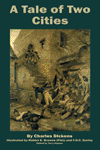
ISBN:
978-1-60459-487-4
|
 |
 |
 |
|
|
|
|
|
|
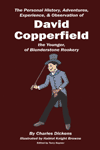 ISBN: ISBN:
978-1-60459-489-8
|
David
Copperfield or The Personal History, Adventures, Experience, &
Observation of David Copperfield the Younger, of Blunderstone Rookery
was published in 1850. Like all except five of Charles Dickens works,
it was originally published in monthly installments. Many elements
within the novel follow events in Dickens’ own life, and it is
considered the most autobiographical of his novels.
David
Copperfield follows the protagonist from childhood to maturity,
beginning with his birth in England in about 1820. David’s father had
died six months before he was born, and seven years later, his mother
marries Mr. Edward Murdstone. David dislikes both his stepfather, and
Mr. Murdstone’s sister Jane, who moves into the house soon afterwards.
David bites Mr. Murdstone while being beaten for falling behind with
his studies, and is sent away to the Salem House boarding school. Many
characters enter, leave, and re-enter Copperfield’s life, including his
faithful housekeeper Peggotty, her family, and their orphaned niece
Little Em’ly who lives with them and charms the young David; his
romantic but self-serving schoolfriend, Steerforth, who seduces and
dishonors Little Em’ly, triggering the novel’s greatest tragedy; his
landlord’s daughter and ideal “angel in the house,” Agnes Wickfield,
who becomes his confidante; David’s sometime mentor, the constantly
debt-ridden Mr. Wilkins Micawber; and the devious and fraudulent clerk,
Uriah Heep.
This edition includes the original 39
illustrations by Hablot Knight Browne, also known as Phiz, the
illustrator of ten of Charles Dickens’ most famous books. |
|
 |
 |
 |
|
|
|
|
|
|
|
|
|
|
Miscellaneous
Books |
|
|
|
|
|
Into this
place fall all the books
that don't have enough to warrant their own category. Fiction,
non-fiction, and religion all appear here. We hope you find something
of interest in this rather eclectic offering.
|
|
|
|
|
|
 |
|
|
|
|
|
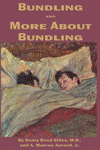 ISBN: ISBN:
978-1-60459-543-7
|
Bundling
was the traditional practice of wrapping one person in a bed
accompanied by another, usually as a part of courting
behavior--essentially, dating in bed. The tradition is thought to have
originated either in the Netherlands or in the British Isles, and later
became common in Colonial America. It was a time when single young men
and women had no easy means of meeting, and in most cases no easy
transport to one another’s homes for brief encounters. For a beau to
meet his girl sometimes required hours of travel, one way, on the only
day he was free of work or chores. The aim of bundling was to allow
intimacy without sexual intercourse. Sometimes it achieved its goal,
other times quick marriages were required to legitimize the forthcoming
baby.
Bundling,
Its Origins, Progress, And Decline in America
(1871), by Henry Reed Stiles, M.D., was the first attempt to examine
this practice and trace its roots in America, and in the British
Isles. His focus was primarily on the New England area, and
Connecticut in particular. Later, in 1928, A. Monroe Aurand, Jr.
reprinted the original text of Bundling,
and added to it a supplement, More
About
Bundling, based on his research in Pennsylvania, with
references to other parts of the world where practices similar to
bundling seem to have been in use.
This volume is the first
reprint of the combined books, and as such is the most thorough study
of the social phenomena made to date. |
|
 |
 |
 |
|
|
|
|
|
|
|
“The
Confidence Man: His Masquerade” was the last major novel
by Herman Melville, the American writer and author of “Moby-Dick,” and was
the first to portray that American icon — the con-man. More
than just a thief, the con-man uses the victim’s own greed (or
desperation) to trick or trap the victim into giving the con-man what
he wants.
Published on April 1, 1857 (presumably the exact
day of the novel's
setting), “The
Confidence-Man” was Melville’s tenth major work in eleven
years. The novel portrays an episodic series of vignettes of various
passengers — some dupes, some tricksters — told as they travel down the
Mississippi River toward New Orleans on that day.
The novel’s title refers to its central character
and his equally
shifty victims, characters in a satirical allegory that is meant to
expose what Melville saw as the smug, mindless materialism of
mid-century America — a gullible greedy American public that can be
deceived by charlatans with the lure of easy money. The events take
place on a Mississippi steamboat on April Fool’s Day, reinforcing
Melville’s remark (in a letter to his friend Henry Savage) that “all
that happens to a man in this life is only by way of a joke.”
Melville’s 1857 black comedy was inspired by the story of a New York
City swindler he read about in a newspaper.
“The
Confidence-Man”
uses the Mississippi River as a metaphor for those broader aspects of
American and human identity that unify the otherwise disparate
characters. Melville also employs the river’s fluidity as a reflection
and backdrop of the shifting identities of his “confidence man.”
|
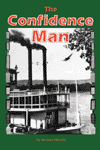
ISBN:
978-1-60459-550-5
|
 |
 |
 |
|
|
|
|
|
|
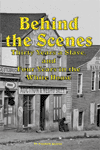 ISBN: ISBN:
978-1-60459-808-7
|
Elizabeth Keckley’s rise from
slave to White House confidante makes for an involving story that
details the cruel and terrible life for those in slavery, and the drive
and determination of a woman who would not let others destroy her will.
“Behind the Scenes —
Thirty Years a Slave, and Four Years in the White
House” provides an honest and accurate portrayal of the
life of a Negro
both as a slave and as a freed-woman.
Elizabeth Keckley was born a slave in 1818. She
endured 37 years of
hard abuse, including whippings that left her bedridden for days and
forced sexual relations (and a resulting pregnancy), before buying
freedom for herself and her son through her skills as a Modiste, or
dressmaker.
Once free, she used her sewing skills to become
one of Washington
D.C.’s most successful dressmakers. She even worked for Senator
Jefferson Davis, the future President of the Confederate States of
America. She came to the attention of Mrs. Lincoln through one of her
clients, and then became Mrs. Lincoln’s exclusive dressmaker, as well
as her close confidante.
After President Lincoln’s assassination she closed
her dress shop to
care for the first lady, and she lost many valuable customers. Sadly, a
misguided attempt to help save Mrs. Lincoln’s reputation with the
publication of this very book ended the friendship, as Mrs. Lincoln
viewed the release of her private conversations and personal letters to
be a cruel betrayal of their relationship.
They never reconciled.
|
|
 |
 |
 |
|
|
|
|
|
|
|
Biography
of a Slave — Being the Experiences of Rev. Charles Thompson, a Preacher
of The United Brethren Church, While a Slave in the South. Together
With Startling Occurrences Incidental To Slave Life. —
Charles Thompson was born in Atala County, Mississippi, near the town
of Rockford, on March 3, 1833. The son of slaves, he spent most of his
life as a slave. This book covers the first half of Thompson’s life,
when all he knew was slavery, and the hope for freedom and the right to
determine his own fate was a bitter dream. He intended to write another
volume covering his life as a minister and the coming of the Civil War
but this was never published.
Reverend Charles Thompson provides a first-hand
account of life during slavery in Mississippi and how he helped grow an
informal community of Christian worshipers among the slaves on his
master’s plantation and neighboring estates. His account uses a
conversational style that Thompson describes as “being much better
suited to the tastes and capacities of my colored readers.” And he is
frank with the terrible state of affairs that the slaves contended with
on a daily basis, from jealous overseers who abused their authority, to
cruel masters who vented their rage on their possessions, much as a
spoiled child will break a toy when angered.
Thompson’s “church” was able to rise and flourish
because it was supported and overseen by his master and mistress, and
he recalls the growth of the congregation and the building of an
official place of worship, in spite of the terrible conditions of
slavery.
|
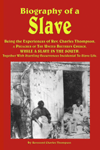
ISBN:
978-1-61720-428-9
|
 |
 |
 |
|
|
|
|
|
|
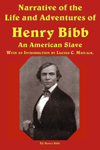 ISBN: ISBN:
978-1-61720-429-6
|
Narrative
of the Life and
Adventures of Henry Bibb, an American Slave
— First
published in 1849 and largely unavailable for many years, “Narrative of
the Life and Adventures of Henry Bibb, an American Slave” is among the
most remarkable slave narratives. Born on a Kentucky plantation in
1815, Bibb first attempted to escape from bondage at the age of ten. He
was recaptured and escaped several more times, in several different
states, with different masters, before he eventually settled in
Detroit, Michigan, and joined the antislavery movement as a lecturer.
Bibb’s story is different in many ways from the
widely read
“Narrative of the Life
of Frederick Douglass, An American Slave” and
Harriet Jacobs’ “Incidents
in the Life of a Slave Girl.” He was owned
by a Native American; he is one of the few ex-slave autobiographers who
had labored in the Deep South (Louisiana); and he writes about folkways
of the slaves, especially how he used conjure magic to avoid punishment
and to woo the hearts of women (unsuccessfully). Most significant, he
is unique in exploring the importance of marriage and family to him,
recounting his several trips to free his wife and child, several of
which resulted in his own recapture by slavers.
For a true and
accurate picture of the life of a slave, and the huge societal pressure
against slaves seeking freedom, both north and south, read this book.
|
|
 |
 |
 |
|
|
|
|
|
|
|
First published in 1906, “Geronimo’s Story of
His Life” is the true account of the life of Geronimo, in
his own
words, narrated in the style of his people.
In the annals of
the Wild West, the one named Geronimo was the most feared of all
Indians. While he preferred peace, he was unafraid to go to war when he
deemed it necessary. He led both the Mexican army, and later the
American, on wild chases across the southwest, and was known as a
fierce fearless fighter who neither asked nor gave any mercies.
Goyahkla was born to the Apache Bedonkohe band,
near Turkey Creek, a
tributary of the Gila River in what is today the state of New Mexico,
but was then part of Mexico. He considered the area to be
their homeland and never desired to leave it. His grandfather (Mako)
had been chief of the Bedonkohe Apache. He had three brothers and four
sisters.
After the death of his father, his mother took him
to
live with the Chihenne (red paint people) and he grew up with them.
When he was 17 he married a woman (Alope) from the Nedni-Chiricahua
band of Apache; they had three children. On March 6, 1858, a company of
400 Mexican soldiers from Sonora attacked Geronimo’s camp outside Janos
while the men were in town trading. Among those killed were Geronimo’s
wife, his children, and his mother. His chief, Mangas-Coloradas, sent
him to Cochise’s band for help in revenge against the Mexicans. It was
the Mexicans who named him Geronimo. This stemmed from a battle in
which, ignoring a deadly hail of bullets, he repeatedly attacked
Mexican soldiers with a knife, causing them to utter appeals to Saint
Jerome (“Jeronimo!”).
|
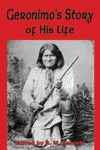
ISBN:
978-1-60459-985-5 |
 |
 |
 |
|
|
|
|
|
|
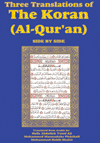 ISBN: ISBN:
978-1-60459-809-4
|
For the first time, in one,
book, are the three most popular English translations of the Qur’an:
the ones by Abdullah Yusuf Ali, Marmaduke Pickthall, and Muhammad Habib
Shakir. Two of them, Abdullah Yusuf Ali and Muhammad Habib Shakir are
Arabic scholars with impressive credentials, while the third is an
English convert to Islam, with equally impressive credentials. For the
first time, the Qur’anic reader can compare different translations of
the Qur’an, and come away with a better understanding of the
Arabic original.
Along with the Jewish Torah and the Christian
Bible, the Islamic Koran (Al-Qur’an) is one of the most important books
in the world, with over 1.5 billion followers across the globe. Unlike
the Torah and the Bible, though, the Qur’an has rarely been translated
to other languages. While there are several English translations of the
Qur’an, most bookstores carry only one, not realizing that others are
available.
Why is this important? Because translating
between languages is as much an art as a linguistic science. Certain
Arabic phrases and words have no direct translation to English and the
translator must carefully choose how he translates that phrase or word,
lest the reader come away with an incorrect understanding of what was
written originally.
If you really want to understand how the
average Islamic believer thinks, then you must read Al-Qur’an, buy your
copy today!
|
| Hardcover: |
 |
|
 |
|
|
| Paperback: |
 |
 |
 |
|
|
|
|
|
|
|
Published near the beginning of World War I
“The Thirty-Nine Steps”
is one of the earliest examples of the
‘man-on-the-run’ thriller archetype in which the author, John Buchan,
holds up Richard Hannay as an example to his readers of an ordinary man
who puts his country’s interests before his own safety. Movie-maker
Alfred Hitchcock was the first director to see the potential appeal of
this novel, which has been made into four movies and a play.
“The
Thirty-Nine Steps” — It is May 1914 and Europe is close
to war with
spies everywhere. Richard Hannay has just returned to London from
Rhodesia in order to begin a new life, when a spy called Franklin P.
Scudder calls on him for help. Scudder reveals that he has uncovered a
German plot to murder the Greek Premier and steal British plans for the
outbreak of war. Scudder claims to be following a ring of German spies
called The Black Stone. A few days later, Hannay returns to his flat to
find Scudder murdered. If Hannay goes to the police, he will be
arrested for Scudder’s murder. Hannay decides to continue Scudder’s
work and his adventure begins, pursued by both the spies and the
police.
“Greenmantle”
— Greenmantle continues the adventures
of Richard Hannay as he is called in to investigate rumors of an
uprising in the Muslim world, and undertakes a perilous journey through
enemy territory to meet up with his friend Sandy in Constantinople.
Once there, he and his friends must thwart the Germans’ plans to use
religion to help them win the war.
“Mr.
Standfast” — Mr.
Standfast is set in the later years of World War I, Richard Hannay, now
a Brigadier-General, is recalled from active service on the Western
Front to undertake a secret mission hunting for a dangerous German
agent at large in Britain. He is forced to work undercover disguised as
a pacifist, roaming the country incognito to investigate the deadly spy
and his agents.
|
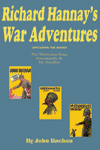
ISBN:
978-1-60459-905-3 |
 |
 |
 |
|
|
|
|
|
|

ISBN:
978-1-61720-425-8
|
This volume has two of the early novels of P.C.
Wren, the author of the famous Beau Geste soldier of fortune series.
“Cupid
in
Africa” — Bertram Walsingham Greene is a clever and
studious
young man who is a sad disappointment to his father, Major Walsingham
Greene. Bertram, who worships the Major, resolves to go to war and
enlists as a Second-Lieutenant in the Indian Army Reserve. He does his
training (such as it is) in India but is soon sent to Africa to take
part in the bloody fighting there. He changes from a
wet-behind-the-ears, but thoroughly nice man into a battle-hardened
fighter and learns a lot about himself as he goes along. The early
stages of the story are rather funny, but as Bertram battles his way
through the jungle and swamp of Africa, leading his men, things become
much more serious in tone. The descriptions of the fighting between the
mostly native troops under British command and the askaris who, under
their German leaders, oppose them are wonderfully done.
“Snake
and Sword” is a powerful book. A pregnant woman, terrified
of poisonous
snakes, is stuck in a dark room with one trapped under her foot. The
mental shock is so great that she transmits it to her unborn child. The
child, Damocles de Warrenne, or Dam, as everyone calls him, grows up
the typical all around British empire builder, except that he collapses
in a “fit” at the sight of any snake. This causes people to think he is
a coward. Instead of becoming an officer in the army he becomes a
private and hides his identity, losing, he fears, the respect and love
of the woman he loves. With a large touch of realism it is the story of
a “fallen gentleman” who remains a “British” gentleman even in the
adversity of the private ranks. Wren is very forthright and
critical of the life of a private soldier—he describes it as being
unnecessarily cruel and tough—and after quite adequately describing the
difficulties of a private in the British cavalry, he mentions that the
only worst military life is the French Foreign Legion.
This
volume includes the complete text of both books, published in 1920, and
1914, respectively.
|
|
 |
 |
 |
|
|
|
|
|
|
|
The
One-Hoss-Shay — Frustrated at the frequent breakdowns of
his shay (a light, covered,
two-wheeled carriage for two persons, drawn by a single horse), the
fictional deacon
in this poem built this wonderful, and perfect, one-horse shay from the
very best of materials so that each part was as strong as every other
part. In Oliver Wendell Holmes Sr.’ humorous, yet “logical”, twist, the
shay endures for a hundred years to the day, then it went to pieces all
at once, and nothing first, — just as bubbles do when they burst.
The second poem, “How the Old Horse won the Bet”,
tells the tale of
the improbable, but not impossible, race of the Deacon’s old, but not
yet retired, horse (unhitched from the shay, of course).
The
last poem, “The
Broomstick Train” whimsically explains the mystery of
how electric trains (and trolleys) move without steam engines or horses
to pull them.
Oliver Wendell Holmes Sr. was a
physician by profession but achieved fame as a writer; he was one of
the best regarded American poets of the 19th century. Included here are
three of his most famous poems.
“The
One-Hoss-Shay, How the Old
Horse Won the Bet, & The Broomstick Train” was
originally
published in 1891. This edition contains the full text of the original
poems and all fifty-nine original illustrations by Howard Pyle.
|

ISBN:
978-1-60459-872-8
|
 |
 |
 |
|
|
|
|
|
|
 ISBN: ISBN:
978-1-61720-124-0
|
Every aspiring author hopes to
become a published professional, but there are many pitfalls on the
way. For every writer who successfully manages to get an article
published, either fiction or fact, there are literally hundreds who
tried and failed.
Emily Flora Klickmann was an English
journalist, author, and editor. She was the editor of the “Girl’s Own
Paper” for 23 years, from 1908 to 1931, as well as
publishing numerous
novels, advice books, children’s stories, and non-fiction on many
topics including gardening, cooking, and needlework techniques.
From her unique position as both an editor and
writer, her book “The
Lure of the Pen,” provides the beginning writer with the advice and
perspective needed to make the right decisions in creating an article
or novel that is ready for publication.
For the fiction writer
she doesn’t merely point out what needs to be done to make believable
characters and situations, but also what needs to be avoided, such as
“peculiarity is not originality” and “slang is quickly out-dated.”
Similarly, for the writer who specializes in the
real world, she
shows examples of how not to write an article (editors do not want
repeat-subjects, verbosity is boring), as well as what will work in
preparing a finished piece that is of interest not only to the editor,
but also to the eventual reader (topicality is important, there is a
time lag between when a magazine buys an article and when it is
actually published).
For both writers, she offers advice on how
to deal with an editor, what is reasonable to expect, what is not. For
example, one of the surest ways to fail at getting published is to
insult the editor, his magazine, or his company, and Flora Klickmann
points out how many aspiring writers do this without even realizing it.
If you’re trying to get what you write published, you need this book!
|
|
 |
 |
 |
|
|
|
|
|
|
|
|
|
|
|
|
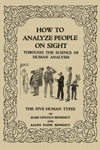 ISBN: ISBN:
978-1-61720-436-4
|
The most essential thing in the
world to any individual is to understand him/herself. The next is to
understand the other people s/he meets. For life is largely a problem
of running your own car as it was built to be run, plus getting along
with the other drivers on the highway.
From this book you are going to learn which type
of car you are and the
main reasons why you have not been getting the maximum of service out
of yourself.
Also you are going to learn the makes of other
human cars, and how to
get the maximum of co-operation out of them. This co-operation is vital
to happiness and success. We come in contact with our fellowman in all
the activities of our lives and what we get out of life depends, to an
astounding degree, on our relations with our fellows.
As the Minneapolis News wrote in November 7, 1920,
“Elsie Lincoln
Benedict is a woman who has studied deeply under genuine scientists and
is demonstrating to thousands at the Auditorium each evening that she
knows the connection between an individual’s external characteristics
and his inner traits.”
|
|
 |
 |
 |
|
|
|
|
|
|
|
|
|
|
|
|
|
Page and contents
Copyright © 2012 by Terry Kepner, All Rights Reserved
Book Covers displayed on this page are Copyright © 2008, 2009, 2010,
2011, 2012 by
Terry Kepner, All Rights Reserved
(please
notify "tkepner" at "aol.com" if you notice any broken links)

|
|
















